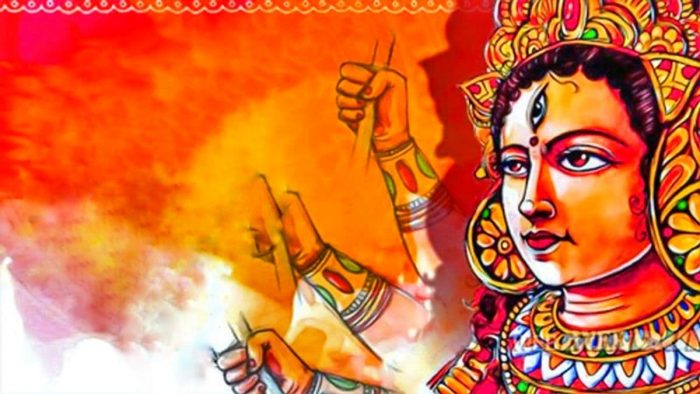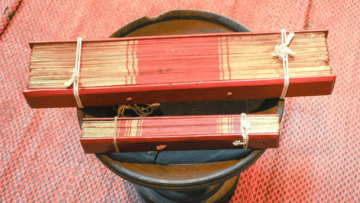Tradition is a repository of knowledge. In Sanatan Dharma, such repositories are filled with various epistemologies to understand reality. The authorities of religions that are threatened by such epistemologies try to break the tradition and thus create a discontinuity.
Whereas, a civilization like Bhārata, that is continuing for millennia has preserved such repositories of knowledge. It doesn’t need to discredit its traditions in the course of time as it gains from it. But when ideologies are pushed upon and institutionalized to falsify and denigrate its past, therein lays a great danger.
One such example is labeling various Purāṇa and Itihāsa as myths, untruth, and inferior to scientific history thereby attempting to make it not fit for mainstream educational purposes. Let us debunk one such allegation by understanding the profound meaning of Mahākālī during this time of Dipāvalī.
A simple story
The Devi in the first chapter of ŚrīDurgāSaptaśatī is Mahākalī. There is the hidden meaning of Mahākalī Upāsanā. The story of the first chapter of ŚrīDurgāSaptaśatī goes like this. There was an emperor named Suratha. He ruled over the entire earth by following his Dharma and treated the commoners like his own son. At this time a king became his enemy and attacked him. He was defeated on the battlefield and had to return to his own city.
But he was again attacked and was looking weak on the battlefield. Thus, his powerful ministers turned wicked and treacherous and took over the emperor’s wealth. After losing his authority he escaped into a dense forest.
He was roaming in the forest when he saw the Āśrama of sage Medhā where many wild animals were resting peacefully. He stayed there for some time. But the thoughts of his once-prosperous kingdom built by his ancestors kept haunting him. He was worried about the future of his people, the empire’s wealth, and so on.
During those days emperor Suratha met a dejected Vaiśya named Samādhi. The Vaiśya was from a wealthy family. But his wicked wife and son pushed him out from the house in the greed for his wealth. His relatives also took away his money. Thus drowned in sorrow he took the road towards the forest. Yet he was craving for his son, wife, and relatives.
The emperor after knowing all this asked him why he is yet filled with affection towards those who cheated on him. Samādhi replied that despite knowing the enormous harm inflicted upon him, he is filled with pity for his son and wife. He was unable to understand this predicament of life. The Vaiśya wanted to get away from such a miserable situation.
So, the emperor and the trader went to Medhā Muni. They sat under the feet of the sage. The emperor then said his mind is not under his control which is making him miserable. He lost his whole empire. He was attached to each and everything of his empire.
In spite of knowing that it is no more, he is filled with despair like a stupid person. And this fellow who was insulted by his wife and son and thrown out of his house is worried for their well being.
Why were they remorseful despite directly knowing the situations that were at fault? Despite being learned why were they craving like foolish persons?
Hearing all this, the sage replied this is not something peculiar with them or for that matter any other human being. The animals too have direct knowledge of their circumstances. A bird in spite of being in hunger first feeds her young ones with grains.
Similarly, a man craves for his son. Everyone is knowledgeable yet they are under the influence of Bhagavatī Mahāmāyā.
This whole world is filled with Māyā by her. She is the Yoganidrārupā of Bhagavān Viṣṇu. The creation, preservation, and destruction of the entire universe are under her control. Only when she is pleased, one gets Mukti from her Māyā.
On further query, the sage described the Mahāmāyā. She is indestructible, unchangeable, and eternal. She neither takes birth nor dies.
The whole world is her creation yet she takes different forms at different times. To explain all this Medhā Muni started narrating a story of the creation to the emperor and the trader.
The Madhu- Kaiṭabha story
Once Bhagavān Viṣṇu was sleeping in Yoganidrā, after the end of time when from the dirt of his ears two Asura named Madhu and Kaiṭabha took birth. These two went towards Brahmāji, who was just born and sitting on the lotus stem arising from the navel of Viṣṇu, to kill him.
Seeing the two Asura coming towards him and Viṣṇu sleeping, Brahmāji started praying to the Yoganidrā with full concentration. He prayed her for waking up Bhagavān Viṣṇu and endow him with intellect to kill those Asura.
Being pleased with the prayers Devi Yoganidrā came out from Viṣṇu. Being freed from Yoganidrā, Viṣṇu woke up from his sleep. He saw the two Asura with red eyes going to engulf Brahmā. Thus he started fighting with them.
The fight went on for thousands of years. Both were out of their mind due to their power and were even engulfed by Māyā. So they asked Viṣṇu to seek a boon from them. Viṣṇu asked them if they are pleased, then get killed by his hands.
They came to know they were betrayed. But they saw the world was then filled with water. Hence, cunningly both asked to be killed in a dry place. Viṣṇu then put their heads on his thigh and killed with his Cakra. This is how sage Medhā narrated a story of how Devi Mahāmāyā took form on being worshipped by Brahmā.
Is this only a story?
It is easy to dismiss this story as a myth or just another fable for a person outside of the tradition. But in this way, we lose the epistemology of this simple yet deep story. Worse is several distortions and prejudices creep in against this beautiful tradition. Let us now look at what the story holds.
The symbolism of Chariot
The emperor was named Suratha. Ratha means a chariot. Now a chariot symbolizes the physical body. The charioteer (Sārathī) is the intellect that drives the chariot i.e. body. The mind is the reins of the chariot which is in the hands of the charioteer (intellect).
The reins (mind) control the horses. The horses refer to the sensory organs. The paths on which the horses (sensory organ) run are the circumstances/sensory objects of the material world.
The owner (Rathī) of this whole chariot set up is the Ātmā. This Jīvātmā (owner) is Bhoktā, when it is attached to the chariot (body), reins (mind), and the horses (sensory organs). So there is the crisis of identity and chaos prevails.
It is so because the owner (Jīvātmā) enjoys the pleasure and suffers the pain of the chariot (body) inflicted by the unrestrained mind (reins) controlling the horses (sensory organs). The true nature of the owner is to be a witness (Draṣṭā) of the set up not to be a Bhoktā (being attached) of the body-mind.
The emperor was Suratha meaning he was filled with noble qualities (Satva Guṇa). So he ruled with Dharma. Yet he was attached (Bhoktā). He was attached to his wealth, his people, and his kingdom. Thus his identity was determined by the impermanent material world.
Naturally, when he kept losing, he became miserable and weak. The wicked and treacherous ministers taking over of the wealth means the rise of Tāmasik Guṇa (destructive qualities). It is a state of darkness, negativity, and inactivity.
Who was Medhā Muni?
The emperor then wanders towards the forest. Forest represents life, a storehouse of knowledge, and inclusivity. Thus the journey into the forest is the seeking of the king driven by the intellect (charioteer or Sārathī).
In the Āśrama of Medhā Muni, the wild animals were resting peacefully. Isn’t it strange? The sage name was Medhā, meaning higher intelligence. He was enlightened with the ultimate truth of the body-mind complex. He is only witnessing all pleasures and pain without being affected.
Thus the resting wild beasts symbolize peace and tranquility. There is no chaos or crisis of identity.
The Nature of Mind
The thoughts of the emperor speak of the nature of the mind. The unrestrained mind always attaches itself either with the past or future. The emperor missed the prosperous kingdom of his ancestors and worried about the future of his people. The role of higher intellect is to guide the mind to the present moment and help it get away from the self-inflicted injury.
The Vaiśya name was Samādhi. The word means to hold oneself in a constant, unchanged, or homogenous state of consciousness. There are no transitory moments of pleasure or pain.
The role of a Vaiśya is to look for profit but here Samādhi is looking for true profit. He is seeking answers for the changing miserable state of his mind. The state of mind is to crave pleasure and being averse to pain.
In this state of craving and aversion of future and past subjects, both the emperor and the trader go to the higher intellect (Medhā). He can help solve the crisis of body-mind. Everybody is rational and learned, yet they fail to get out of this habit pattern of mind.
Humans are no different than animals and birds when they are attached to the chariot of body-mind. This is the true knowledge that he imparts through another story.
What is Māyā?
Māyā is today wrongly conceived as something evil or illusion. Māyā is not good or evil. It is simply a statement of facts. It is the nature of the universe.
This nature the emperor and the trader are unable to comprehend. There is nothing to idealize or detest in this. Māyā is that exists and at the same time does not exist.
This is apparent existence and the nature of real existence. It is the creation of Mahāmāyā. She is defined as indestructible, unchangeable, and timeless.
It is only the sensory organs and the minds that see birth and death and observe the changes in time. Mahāmāyā is beyond senses yet she is the all-pervading principle. She is inseparable from existence and eternal.
The owner of the chariot – Rathī (Jīvātmā) has to be detached from the chariot (body-mind) and be a witness to comprehend her. She is the Devi of Tāmasik Guṇa. So she is fierce, dark, and ugly.
Yet she is beautiful, soothing, and caring. So when she is inside Viṣṇu, he is in deep slumber, in a state of idleness and blissful inactivity. He is in Yoganidrā. Brahmā sits on the navel of Viṣṇu.
The navel center is the womb of creation. The womb of Viṣṇu is the Hiraṇyagarbha. It is the cosmic womb, the womb of creation of all universe, the all-pervading consciousness. So Brahmā, the creator, sits there.
Are Madhu and Kaiṭabha dead?
The two Asura named Madhu and Kaiṭabha is born from the dirt of the ear of Viṣṇu. What does this mean? Ear symbolizes sound. Everything we see is waves of vibration. The simplest of sub-atomic particles are also vibrating. Our thoughts are even subtle vibrations.
Dirt symbolizes knowledge devoid of distinguishing intellect. So the two Asura are our thoughts unable to distinguish what is desirable and undesirable.
Madhu is craving for pleasure and Kaiṭabha is averse to pain. So they are the nature of our mind that overpowers our intellect. They have red eyes referring to anger, lust, greed, and other emotions that take over us.
Brahmā prays to Yoganidrā and asks her to come out of Viṣṇu. As long as Tāmasik Guṇa is within us we can’t fight against our mind. So Brahmāji worshipped her with Ekāgra Citta – complete concentration to win over the pulsating nature of mind.
With Tāmasik Guṇa out of Viṣṇu, he was able to fight the two Asura (craving and aversion). But the fight went on for thousands of years. This conveys it is not easy to get mastery over the mind and be detached in a short span. One needs perseverance and dedicated effort.
The Asura, Madhu (craving), and Kaiṭabha (aversion) are mad in power. Similarly, our mind loses sanity when engulfed in these two traits. But it is not fatalistic. They can be tricked and tamed with practice just as the two Asura were tricked by Viṣṇu.
But why they couldn’t be killed in water and had to be killed on thighs? This is again symbolism at play. Water pervading everywhere is Prāṇa – the life force. There is no death here rather boundless life. On the other hand, the thigh symbolizes sexuality.
The mind is always associated with sensory objects. When one is deeply attached to sensory objects it is a state of death. Hence, they were killed upon thighs.
This is a simple story yet holding the essence of the entire cosmos, from the microcosm to the macrocosm. The tradition has innumerable ways of conveying the complex truth in a simple and engaging way. So denigrating the tradition as myths and fantasy is nothing sort of digging the grave for the civilization.
References
- SriDurgaSaptasati, Hindi Translation by Sri Ramnarayan Dutt Ji Shastri, Gita press, Gorakhpur.
- Kathokopanishad by Kailash Vidya Prakashan, Kailash Ashram, Rishikesh.
- Unpublished Manuscripts of Swami Nityananda Giri, Author of Kriya Yoga- The Science of Life Force.
Disclaimer: The opinions expressed in this article belong to the author. Indic Today is neither responsible nor liable for the accuracy, completeness, suitability, or validity of any information in the article.








